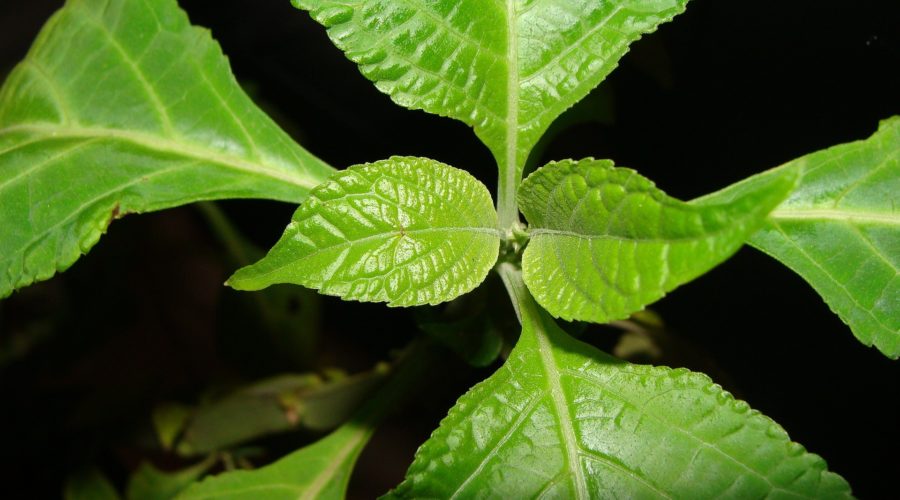Salvia Divinorum (Diviner’s Sage) – Seeds, Effects & More
Salvia divinorum, or salvia for short, is a psychedelic plant that can be chewed, smoked, or consumed as a tea to achieve psychoactive effects.
Traditionally, Salvia divinorum leaves are chewed or turned into a tea using extracted leaf juices. Smoking the dried leaves is a more modern method that helps to more effectively absorb the psychoactive compound contained in the plant.
When smoked, salvia results in a short (and often very intense) psychedelic experience, similar to a DMT trip. However, salvia differs from DMT — and the other classic psychedelics — in some important ways.
The Latin name Salvia divinorum translates to “sage of the diviners” or “diviner’s sage”. The plant also goes by the names ska maría pastora, seer’s sage, and yerba de la pastora.
What Is Salvia Divinorum?
Salvia is a perennial herb of the largest genus of plants in the Labiatae (mint) family. It is native to the cloud forest regions of the Sierra Mazateca in Oaxaca, Mexico, and typically grows in ravines and other high-altitude, humid areas.
Salvia divinorum plants can reach over one meter in height and have large green leaves, hollow square stems, and white flowers with purple calyces.
Salvia is a genus, to which 1000 species belong to. However, only Salvia divinorum possesses psychoactive properties.
The History Of Diviner’s Sage
The history of Salvia divinorum is not well known. There has been no definitive answer to the question of its origin. It may be a wild plant native to the Sierra Mazateca, a cultigen (a deliberately altered plant) of the Mazatecs, or a cultigen introduced by another indigenous group. Botanists have not been able to determine whether the plant is a hybrid or a cultigen.
Nonetheless, there are other historical aspects of the plant we do know about.
Salvia divinorum has a long history of use among the Mazatec Indians of Oaxaca, who revere the plant as an incarnation of the Virgin Mary. This is why it has long been locally known as hierba (herb) or hojas (leaves) de María. It is traditionally used for healing and divination (attempting to foretell future events), hence why the specific epithet, divinorum, was given to the plant.
The American anthropologist Jean Basset Johnson first recorded diviner’s sage in print in 1939 while he was studying Mazatec shamanism. He later documented its usage and reported its effects through personal testimonials.
The Swiss chemist, Albert Hofmann, who collected salvia plants with Gordon Wasson, objected to the plant being given the name divinorum:
“I was not very happy with the name because Salvia divinorum means “Salvia of the ghosts”, whereas Salvia divinatorum, the correct name, means ‘Salvia of the priests’.”
However, it is now in the botanical literature under the name Salvia divinorum due to priority rules.
Wasson, who popularized psilocybin mushrooms, proposed that the plant could be the mythological pipiltzintzintli, the “Noble Prince” described in the Aztec codices. This speculation has generated debate amongst ethnobotanists.
In the 1990s, a team of researchers — led by Daniel Siebert — identified the compound responsible for the plant’s psychoactive effects.
The Pharmacology Of Salvia Divinorum
The known psychoactive compound in salvia is salvinorin A. This is present in the dried plant at a concentration of about 0.18 percent, corresponding to 0.022 percent on a fresh weight basis.
Salvinorin A is structurally distinct from other naturally occurring psychedelics, including DMT, psilocybin, and mescaline, as well as synthetic psychedelics like LSD. This is because it contains no nitrogen atoms. Hence, it is not an alkaloid (and cannot be rendered as a salt).
By mass, salvinorin A is the most potent naturally occurring psychedelic compound. It is active at doses as low as 200 µg (micrograms). Synthetic psychedelics, such as LSD (active at 20-30 µg doses), can be more potent.
Salvinorin A’s potency should not be confused with toxicity, however. Rodents have been given dosages many times greater than those people take, and show no signs of organ damage.
Research has shown that salvinorin A is a potent κ-opioid (kappa-opioid) receptor agonist. This means that it binds to and activates this type of receptor, with a high probability of occupying that receptor at any given instant or drug concentration.
Studies have shown that the effects of salvinorin A in mice are blocked by κ-opioid receptor antagonists. These are substances that block or dampen the response of a receptor when they bind to it.
Unlike classic psychedelics such as mescaline or LSD, salvinorin A has no actions at the 5-HT2A serotonin receptor. The main psychedelic effects of the former substances are mediated through this receptor action. Salvinorin A also has no actions at the 5-HT2C or dopamine receptors, which classic psychedelics also activate to a certain degree.
The Effects Of Salvia Divinorum
Many people using diviner’s sage compare the experience to DMT for several reasons. Smoking the dried leaves (especially potent extracts) can result in a short-lasting, intense experience, with many users reporting traveling to other dimensions and meeting strange entities — similar to DMT elves.
Nonetheless, due to salvinorin’s A unique pharmacology, salvia offers a type of psychedelic experience that is distinct from that induced by DMT and other classic psychedelics.
Many users find that salvia’s atypical psychedelic effects can be unpleasant, although some psychonauts find great value in working with the plant. Generally, psychedelic users find that salvia does not result in profound personal insights but instead tends to produce powerful and strange experiences.
Physical Effects
- Sedation
- Changes in felt gravity (the sensation of being pushed, pulled, or lifted out of one’s body)
- Changes in felt bodily form (the non-painful sensation of being stretched horizontally or vertically into infinity, splitting into two halves, and a variety of other sudden changes)
- Spontaneous bodily sensations
- Spatial disorientation
- Motor control loss
- Slurred speech
Visual Effects
- Depth perception distortions
- Seeing objects and scenery morphing, melting, or breathing
- Perspective distortions (objects or surroundings changing in physical size)
- Scenery slicing
- Perceiving hallucinatory structures in darkness or with eyes closed
- At higher doses, there can be internal hallucinations with plots, scenarios, settings, and entity contact
Emotional Effects
- Euphoria
- Anxiety
- Paranoia
- Panic
- Confusion
- Dysphoria
Cognitive Effects
- Amnesia
- Delusion
- Depersonalization
- Increased music appreciation
- Laughter fits
- Thought deceleration
- Time distortion
How To Grow Salvia Divinorum
Although it is possible to grow salvia from Salvia divinorum seeds, this is more difficult than growing from cuttings.
Here’s how to cultivate a salvia cutting:
- Step 1: Clean the cutting by removing any dead or blackened material. Also, remove any leaves that would end up below soil level.
- Step 2: Fill a small pot to two-thirds capacity with fresh potting soil. Don’t use soil from outside as this may contain pests that can kill the cutting. Potting soil bought from a garden center will be cleaner and contain the right balance of nutrients for a young plant. Ensure the pot has drainage holes that will prevent the soil from becoming waterlogged.
- Step 3: Using your finger, make a hole in the center of the soil about 5 cm deep. Place your cutting into the hole and fill around the roots with potting soil.
- Step 4: Administer a small amount of water to the soil around the plant, and mist the plant with a spray bottle.
- Step 5: Place a transparent plastic bag over the plant, and secure it at the base of the pot with an elastic band. This will raise and maintain the high level of humidity needed for the cutting to thrive. Using a large ziplock bag will make watering the plant easier. Whichever bag you use, make sure it doesn’t restrict or bend the plant.
- Step 6: Place the cutting in a bright and warm location. Filtered sunlight is best, as salvia plants don’t like direct sunlight, nor do they like heavy shade.
- Step 7: Your salvia plant should now begin to grow and flourish. Leave it to grow in the bag for about a week. For the following two weeks, punch one or two holes in the bag each day. This will gradually reduce the humidity within the bag.
- Step 8: After two weeks of slowly acclimatizing the salvia cutting, you can remove the bag. If it starts to wilt, replace the bag for another week.
- Step 9: You can now carefully transplant the plant to a larger pot. Your salvia should now be established.
Where To Buy Salvia Divinorum
Where you can buy salvia will depend on the country you live in, as the plant’s legality differs around the world (as we discuss in the next section).
While it used to be possible to buy salvia extracts in headshops in countries like the United States and the United Kingdom, legislation brought in made this illegal in many states, as well as through the United Kingdom.
It’s often possible to buy Salvia divinorum seeds, plants, leaves, cuttings, and extracts online and shipped to your home. However, this can come with risks. It’s important to find out whether or not this is legal to do in your state or country.
The odd nursery in legal U.S. states may stock Salvia divinorum plants, but the chances are slim. Most nurseries and garden centers stock many species of Salvia, but divinorum is not often one of them. Due to the plant’s psychedelic properties, many large nurseries avoid the plant.
Is Salvia Divinorum Legal?
Salvia is unregulated in most countries, including the United States at a federal level, although it is illegal in 29 states (and the territory of Guam).
Some countries currently ban both the plant and its active chemical constituent, salvinorin A. Here’s where salvia is illegal:
- Armenia
- Australia
- Belgium
- Brazil
- Bulgaria
- Canada
- Croatia
- Czech Republic
- Germany
- Ireland
- Latvia
- Lithuania
- Japan
- Poland
- Portugal
- Philippines
- Romania
- Russia
- Singapore
- South Korea
- Sweden
- Switzerland
- Ukraine
- United Kingdom
You should be aware that laws regulating salvia use, possession, cultivation, and sale are subject to change. So you need to research laws in your area before deciding to buy, sell, or grow the plant.



